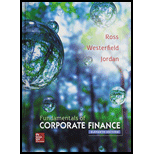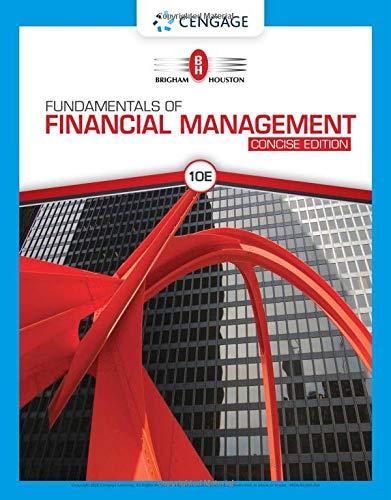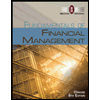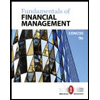
a)
To compute: The value of Publication IR to Company B.
Introduction:
Merger is the complete absorption of one company by another company. The acquiring company acquires all the assets and liabilities of the acquired firm and acquiring firm retains its name and identity. The acquired firm ceases to exist as a separate business entity after a merger.
a)
Answer to Problem 14QP
The value of Publications I to Company B is $9,857,250.
Explanation of Solution
Given information:
“Company B” is analysing the purchase of “Publications I”. Company B expects that earnings and dividends of Publications I to grow at a constant rate of 5% every year. Because of synergy, Company B’s growth rate will increase to 7% each year.
The price earnings ratio of Company B and Publications I are 14.5% and 9.2% respectively. The outstanding shares of Company B and Publications I are $1,400,000 and $195,000 respectively. The earnings of Company B and Publications I are $4,300,000 and $705,000 respectively and the dividends of Company B and Publications I are $1,075,000 and $375,000 respectively.
Formula to calculate the value of Publications I to Company B:
Calculate the value of Publications I to Company B:
Hence, the value of Publications I to Company B is $3.61538 per share.
Formula to calculate the share price of Target Company (I Publications):
Calculate the share price of Target Company (I Publications):
Hence, the share price of the target company is $33.261496.
Formula to calculate the dividend per share:
Calculate the dividend per share:
Hence, the dividend of Publications I is $1.923.
Formula to calculate the required
Calculate the required rate of return for the target company’ shareholders:
Hence, the required return of Publications I is 11.07%.
Formula to calculate the share price of the target company with new growth rate:
Calculate the share price of the target company with new growth rate:
Hence, the share price of the target company is $50.55.
Formula to calculate the value of Publications I to Company B:
Calculate the value of Publications I to Company B:
Hence, the value of Publications I to Company B is $9,857,250.
b)
To compute: The gain of Company B from the acquisition.
Introduction:
Merger is the complete absorption of one company by another company. The acquiring company acquires all the assets and liabilities of the acquired firm and acquiring firm retains its name and identity. The acquired firm ceases to exist as a separate business entity after a merger.
b)
Answer to Problem 14QP
Company B’s gain from acquisition is $3,371,258.28.
Explanation of Solution
Given information:
“Company B” is analysing the purchase of “Publications I”. Company B expects that earnings and dividends of Publications I to grow at a constant rate of 5% every year. Because of synergy, Company B’s growth rate will increase to 7% each year.
The price earnings ratio of Company B and Publications I are 14.5% and 9.2% respectively. The outstanding shares of Company B and Publications I are $1,400,000 and $195,000 respectively. The earnings of Company B and Publications I are $4,300,000 and $705,000 respectively and the dividends of Company B and Publications I are $1,075,000 and $375,000 respectively.
Formula to calculate Company B’s gain from the acquisition:
Calculate Company B’s gain from the acquisition:
Hence, Company B’s gain from acquisition is $3,371,258.28.
c)
To compute: The
Introduction:
Merger is the complete absorption of one company by another company. The acquiring company acquires all the assets and liabilities of the acquired firm and acquiring firm retains its name and identity. The acquired firm ceases to exist as a separate business entity after a merger.
c)
Answer to Problem 14QP
The NPV of the acquisition is $2,447,250.
Explanation of Solution
Given information:
“Company B” is analysing the purchase of “Publications I”. Company B expects that earnings and dividends of Publications I to grow at a constant rate of 5% every year. Because of synergy, Company B’s growth rate will increase to 7% each year.
The price earnings ratio of Company B and Publications I are 14.5% and 9.2% respectively. The outstanding shares of Company B and Publications I are $1,400,000 and $195,000 respectively. The earnings of Company B and Publications I are $4,300,000 and $705,000 respectively and the dividends of Company B and Publications I are $1,075,000 and $375,000 respectively.
Formula to calculate the NPV of the acquisition, if Company B offers $38 in cash for each share of Publications I:
Calculate the NPV of the acquisition, if Company B offers $38 in cash for each share of Publications I.
Hence, the NPV of the acquisition at $38 offer price is $2,447,250.
d)
To compute: The maximum bidding price that Company B will be willing to pay for Publications I.
Introduction:
Merger is the complete absorption of one company by another company. The acquiring company acquires all the assets and liabilities of the acquired firm and acquiring firm retains its name and identity. The acquired firm ceases to exist as a separate business entity after a merger.
d)
Answer to Problem 14QP
The maximum bid price is $50.55.
Explanation of Solution
Given information:
“Company B” is analysing the purchase of “Publications I”. Company B expects that earnings and dividends of Publications I to grow at a constant rate of 5% every year. Because of synergy, Company B’s growth rate will increase to 7% each year.
The price earnings ratio of Company B and Publications I are 14.5% and 9.2% respectively. The outstanding shares of Company B and Publications I are $1,400,000 and $195,000 respectively. The earnings of Company B and Publications I are $4,300,000 and $705,000 respectively and the dividends of Company B and Publications I are $1,075,000 and $375,000 respectively.
Formula to calculate the maximum bid price:
Hence, Company B’s maximum bid price is $50.55.
e)
To compute: The NPV of the acquisition, if Company B was offered $205,000 of its shares for the stock outstanding of Publications I.
Introduction:
Merger is the complete absorption of one company by another company. The acquiring company acquires all the assets and liabilities of the acquired firm and acquiring firm retains its name and identity. The acquired firm ceases to exist as a separate business entity after a merger.
e)
Answer to Problem 14QP
The NPV is $634,300.
Explanation of Solution
Given information:
“Company B” is analysing the purchase of “Publications I”. Company B expects that earnings and dividends of Publications I to grow at a constant rate of 5% every year. Because of synergy, Company B’s growth rate will increase to 7% each year.
The price earnings ratio of Company B and Publications I are 14.5% and 9.2% respectively. The outstanding shares of Company B and Publications I are $1,400,000 and $195,000 respectively. The earnings of Company B and Publications I are $4,300,000 and $705,000 respectively and the dividends of Company B and Publications I are $1,075,000 and $375,000 respectively.
Formula to compute the EPS of Company B:
Calculate the EPS of Company B:.
Hence, the EPS of Company B is $3.07143.
Formula to calculate the share price of Company B:
Calculate the share price of Company B:
Hence, the share price of Company B is $44.5357.
Formula to calculate the market value of Company B:
Calculate the market value of Company B:
Hence, the market value of Company B is $62,349,980.
Formula to calculate the price of the stock in the merged firm:
Calculate the price of the stock in the merged firm:
Hence, the price of the merged firm stock is $44.99.
Formula to calculate the NPV:
Calculate the NPV:
Hence, NPV is $634,300, if Company B offers 205,000 shares in exchange for outstanding stock of Publications I.
f)
To discuss: Whether the acquisition must be attempted and the acquisition that must be tried.
Introduction:
Merger is the complete absorption of one company by another company. The acquiring company acquires all the assets and liabilities of the acquired firm and acquiring firm retains its name and identity. The acquired firm ceases to exist as a separate business entity after a merger.
f)
Explanation of Solution
Given information:
“Company B” is analysing the purchase of “Publications I”. Company B expects that earnings and dividends of Publications I to grow at a constant rate of 5% every year. Because of synergy, Company B’s growth rate will increase to 7% each year.
The price earnings ratio of Company B and Publications I are 14.5% and 9.2% respectively. The outstanding shares of Company B and Publications I are $1,400,000 and $195,000 respectively. The earnings of Company B and Publications I are $4,300,000 and $705,000 respectively and the dividends of Company B and Publications I are $1,075,000 and $375,000 respectively.
Yes, the acquisition should go further, and Company B should offer cash of $38 for each share of Publications I.
g)
To compute: The NPV, if the outside financial consultants of Company B feel that the growth rate is very optimistic at 7% and it is realistic at 6%.
Introduction:
Merger is the complete absorption of one company by another company. The acquiring company acquires all the assets and liabilities of the acquired firm and acquiring firm retains its name and identity. The acquired firm ceases to exist as a separate business entity after a merger.
g)
Answer to Problem 14QP
The reduction in growth rate, results in positive NPV for cash offer and negative NPV for stock offer.
Explanation of Solution
Given information:
“Company B” is analysing the purchase of “Publications I”. Company B expects that earnings and dividends of Publications I to grow at a constant rate of 5% every year. Because of synergy, Company B’s growth rate will increase to 7% each year.
The price earnings ratio of Company B and Publications I are 14.5% and 9.2% respectively. The outstanding shares of Company B and Publications I are $1,400,000 and $195,000 respectively. The earnings of Company B and Publications I are $4,300,000 and $705,000 respectively and the dividends of Company B and Publications I are $1,075,000 and $375,000 respectively.
Formula to calculate the share price of the target company with changed growth rate:
Calculate the share price of the target company with changed growth rate.
Hence, the share price of the target company with changed rate of growth is $40.20.
Formula to calculate the value of Publications I to Company B:
Calculate the value of Publications I to Company B:
Hence, the value of Publications I to Company B is $7,839,000.
Formula to calculate Company B’s gain from acquisition:
Calculate Company B’s gain from acquisition:
Hence, the gain is $6,485,991.72.
Formula to calculate the NPV of the acquisition, if Company B offers $38 in cash for each share of Publications I.
Calculate the NPV of the acquisition, if Company B offers $38 in cash for each share of Publications I.
Hence, the NPV for cash is 429,000.
Formula to calculate the price of the stock in the merged firm:
Calculate the price of the stock in the merged firm:
Hence, the price of the merged stock firm is $43.73.
Formula to calculate the NPV for stock offer:
Calculate the NPV for stock offer:
Note:
- EPS represents Earnings Per Share
- NPV represents Net Present Value
- P represents Share price
- DPS represents Dividend Per Share
- V represents Market Value
Hence, the NPV for stock is -$1,125,650.
Want to see more full solutions like this?
Chapter 26 Solutions
Fundamentals of Corporate Finance with Connect Access Card
- A bond with a face value of $1,000 and a coupon rate of 5% pays how much interest annually?A. $10B. $50C. $500D. $5arrow_forwardWhich of the following is NOT a typical characteristic of a bond? a) Fixed interest paymentsb) Principal repayment at maturityc) Ownership in the companyd) Issued by governments or corporationsarrow_forwardDon't use Ai. In the context of financial markets, what does liquidity refer to? a) The ability to generate profitsb) The ability to buy or sell an asset without affecting its price significantlyc) The ability to pay off liabilitiesd) The number of shares in circulationarrow_forward
- I need help!! In the context of financial markets, what does liquidity refer to? a) The ability to generate profitsb) The ability to buy or sell an asset without affecting its price significantlyc) The ability to pay off liabilitiesd) The number of shares in circulationarrow_forwardWhat is the main risk associated with investing in stocks? a) Credit riskb) Market riskc) Inflation riskd) Liquidity riskarrow_forwardWhich of the following is an example of a fixed income security? a) Stockb) Treasury Bondc) Mutual Fundd) Real Estate Investment Trust need help!arrow_forward
- I need help in this: The price-to-earnings (P/E) ratio is used to assess: a) A company’s profitabilityb) A company's debt-to-equity ratioc) The market value relative to earningsd) The liquidity of a stockarrow_forwardWhich of the following is an example of a fixed income security? a) Stockb) Treasury Bondc) Mutual Fundd) Real Estate Investment Trustarrow_forwardThe price-to-earnings (P/E) ratio is used to assess: a) A company’s profitabilityb) A company's debt-to-equity ratioc) The market value relative to earningsd) The liquidity of a stockarrow_forward
- What does the term "capital structure" refer to? a) The organization of a company’s operationsb) The mixture of debt and equity used to finance a company's assetsc) The relationship between income and expensesd) The structure of a company's management teamarrow_forwardThe Efficient Market Hypothesis (EMH) suggests that: a) All information is publicly available, but not necessarily reflected in stock pricesb) Stocks are always mispriced in the short termc) All public information is fully reflected in stock pricesd) Investors can achieve higher returns through technical analysisarrow_forwardDon't use ai tool please . What is the primary purpose of diversification in a portfolio? a) To maximize returnsb) To reduce riskc) To increase leveraged) To focus on a single asset classarrow_forward

 Financial Reporting, Financial Statement Analysis...FinanceISBN:9781285190907Author:James M. Wahlen, Stephen P. Baginski, Mark BradshawPublisher:Cengage Learning
Financial Reporting, Financial Statement Analysis...FinanceISBN:9781285190907Author:James M. Wahlen, Stephen P. Baginski, Mark BradshawPublisher:Cengage Learning Intermediate Financial Management (MindTap Course...FinanceISBN:9781337395083Author:Eugene F. Brigham, Phillip R. DavesPublisher:Cengage Learning
Intermediate Financial Management (MindTap Course...FinanceISBN:9781337395083Author:Eugene F. Brigham, Phillip R. DavesPublisher:Cengage Learning Fundamentals Of Financial Management, Concise Edi...FinanceISBN:9781337902571Author:Eugene F. Brigham, Joel F. HoustonPublisher:Cengage Learning
Fundamentals Of Financial Management, Concise Edi...FinanceISBN:9781337902571Author:Eugene F. Brigham, Joel F. HoustonPublisher:Cengage Learning Fundamentals of Financial Management, Concise Edi...FinanceISBN:9781285065137Author:Eugene F. Brigham, Joel F. HoustonPublisher:Cengage Learning
Fundamentals of Financial Management, Concise Edi...FinanceISBN:9781285065137Author:Eugene F. Brigham, Joel F. HoustonPublisher:Cengage Learning Fundamentals of Financial Management, Concise Edi...FinanceISBN:9781305635937Author:Eugene F. Brigham, Joel F. HoustonPublisher:Cengage Learning
Fundamentals of Financial Management, Concise Edi...FinanceISBN:9781305635937Author:Eugene F. Brigham, Joel F. HoustonPublisher:Cengage Learning





